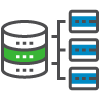Cloud Network
Access from everywhere to anywhere.
In the Cloud Network the core functions of the network are not only software-defined, but every networking function is virtualized and delivered as a service, including optimal packet path selection and security policy enforcement. The Cloud Network provides enterprise-grade application performance, unprecedented orchestration visibility, and reliable network connectivity, application access, performance and security to users at every location.

The workplace is vibrant, unpredictable, demanding, unbounded.
Your users move around everywhere, they work from assorted places—increasingly from locations you do not own or control—and insist on using a plethora of different devices to access an ever-larger number of cloud-based applications. Every branch office must access the enterprise-wide inventory system, and everyone in the organization must access the employee-benefits site. There are no perimeters left in your network, no local applications, no definable set of end user devices, no telling where the next employee or worker may be and what application they might need.
And your job is to make sense of this and provide secure access for every worker from wherever they are to access everything they might need to get their job done. And do it with the appropriate and expected application performance. This is really hard to do with a traditional network architecture.
Data migrated to the cloud, as did computing resources and applications. This transition provided unrivaled ease of management, elasticity to shrink or grow as needed, and ubiquitous access, all with optimized operational costs and frequently leveraging already-invested-in resources.
Now network services are being transformed by the same software-defined virtualization principles that revolutionized enterprise application and computing architectures. Cloud-based networks provide solutions to the energetic and unpredictable distributed enterprise that strains traditional network architectures characterized by strict public-private demarcations, and strong dependence on geographic location and ownership of network hardware.

The network is the cloud,
and the cloud is the network.
Cloud-based networks provide solutions to the energetic and unpredictable distributed enterprise that strains traditional network architectures characterized by strict public-private demarcations, and strong dependence on geographic location and ownership of network hardware.





